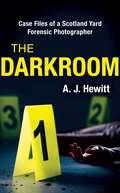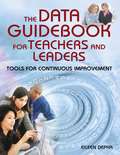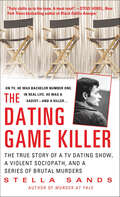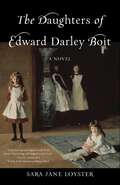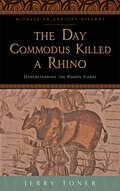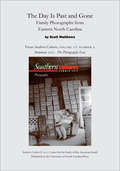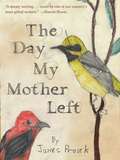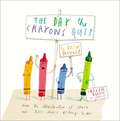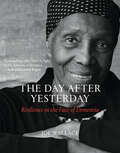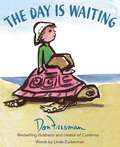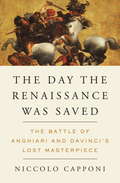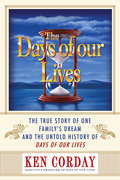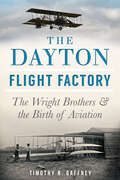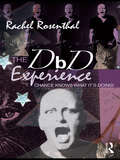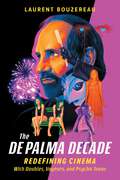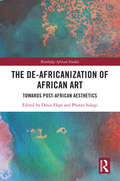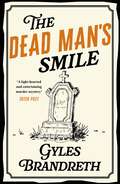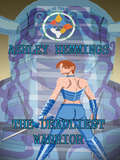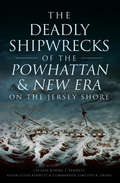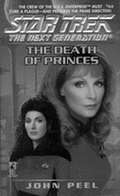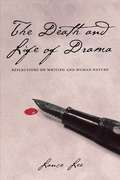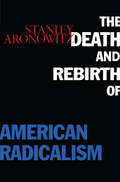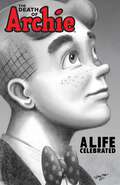- Table View
- List View
The Darkroom: Case Files of a Scotland Yard Forensic Photographer
by A.J. HewittIt was my job to look and look and never look away, until I had captured every part of the scene, until I had told the story of those last moments that the dead could not... For years, A.J. Hewitt was the first person into a crime scene. Before the detectives and the forensics team it was her alone with the body, the only sound her flashes firing as they lit up scenes of unimaginable horror. It was her job to shoot the photographs that revealed the circumstances of someone's final moments. Now in her debut book, The Darkroom, Hewitt takes us into the shadowy world of the crime scene photographer, and recounts remarkable tales, from murders to suicides, accidents to assassinations.In the tradition of Unnatural Causes, When the Dogs Don't Bark and All That Remains, this is a true crime book full of the wisdom that can be found in the darkness.
The Data Guidebook for Teachers and Leaders: Tools for Continuous Improvement
by Eileen DepkaAre you looking for new ways to use data in the decision-making process? Are you seeking tools that provide better flow-through from data to improved student achievement? Have you ever considered including students in the data-to-improvement cycle? Schools recognize that data is an essential decision-making tool, but it requires teamwork and reflection to reap the maximum benefits. This guidebook offers practical collection and analysis methods and templates as well as tips for building trust and working together.
The Dating Game Killer: The True Story of a TV Dating Show, a Violent Sociopath, and a Series of Brutal Murders (St. Martin's True Crime Classics)
by Stella SandsThe true crime story of the California serial killer who won a date on the 1970s TV show The Dating Game during his killing spree.The real story behind the Anna Kendrick Netflix film Woman of the Hour In 1978, Rodney Alcala was a contestant on The Dating Game, one of America&’s most popular television shows at the time. Handsome, successful, and romantic, he was embraced by the audience—and chosen as the winner by the beautiful bachelorette. To viewers across the country, Rodney seemed like the answer to every woman&’s dreams. Until they learned the truth about his once and future crimes... Ten years before his TV appearance, Rodney was charged with the sexual assault and attempted murder of an eight-year-old girl. In the decades that followed, he would be accused of seven murders—and, as new DNA evidence continues to be uncovered, the list may grow. The case is so disturbing that it&’s been documented in several news outlets, from People magazine and USA Today to 48 Hours Mystery and Dr. Phil. The Dating Game Killer is the shocking true story about the dark and twisted man. &“Ms. Sands presents the crimes and evidence with professional skill and objectivity…. A must read!&”—Steve Hodel, New York Times bestselling true-crime author, Black Dahlia Avenger: A Genius for Murder, Detective Supervisor, LAPD Hollywood Homicide Division
The Daughters of Edward Darley Boit: A Novel
by Sara LoysterWhen fifteen-year-old Victoria grudgingly accompanies her mother to the Museum of Fine Arts in Boston, she has no idea her life is about to change forever. While there, she falls under the spell of the famous John Singer Sargent portrait The Daughters of Edward Darley Boit. Drawn into the portrait’s shadowy depths, Victoria finds herself transported back in time to the world of the four troubled Boit sisters. By the time she returns to her own world, Victoria understands that the sisters are in serious trouble and need her help. She dedicates herself to solving the mystery of their peculiar loneliness and isolation—only to discover that at the same time she is having an impact on the Boit sisters’ future, they are having an equally dramatic effect on her own. Spanning a brief period in the lives of John Singer Sargent and the Boit family, The Daughters of Edward Darley Boit is a coming-of-age tale that explores both the murky world of Paris in 1882 and the upheaval going on in Victoria’s own time, the early sixties, all the while pondering possible answers to the questions raised by Sargent’s most enigmatic work of art.
The Day Commodus Killed a Rhino: Understanding the Roman Games (Witness to Ancient History)
by Jerry TonerIn ancient times, the Roman games—that heady cocktail of mass slaughter, gladiatorial combat, and chariot racing—made strong political, social, and cultural statements.The Roman emperor Commodus wanted to kill a rhinoceros with a bow and arrow, and he wanted to do it in the Colosseum. Commodus’s passion for hunting animals was so fervent that he dreamt of shooting a tiger, an elephant, and a hippopotamus; his prowess was such that people claimed he never missed when hurling his javelin or firing arrows from his bow. For fourteen days near the end of AD 192, the emperor mounted one of the most lavish and spectacular gladiatorial games Rome had ever seen. Commodus himself was the star attraction, and people rushed from all over Italy to witness the spectacle. But this slaughter was simply the warm-up act to the main event: the emperor was also planning to fight as a gladiator.Why did Roman rulers spend vast resources on such over-the-top displays—and why did some emperors appear in them as combatants? Why did the Roman rabble enjoy watching the slaughter of animals and the sight of men fighting to the death? And how best can we in the modern world understand what was truly at stake in the circus and the arena? In The Day Commodus Killed a Rhino, Jerry Toner set out to answer these questions by vividly describing what it would have been like to attend Commodus’ fantastic shows and watch one of his many appearances as both hunter and fighter. Highlighting the massive logistical effort needed to supply the games with animals, performers, and criminals for execution, the book reveals how blood and gore were actually incidental to what really mattered. Gladiatorial games played a key role in establishing a forum for political debate between the rulers and the ruled. Roman crowds were not passive: they were made up of sophisticated consumers with their own political aims, which they used the games to secure. In addition, the games also served as a pure expression of what it meant to be a true Roman. Drawing on notions of personal honor, manly vigor, and sophisticated craftsmanship, the games were a story that the Romans loved to tell themselves about themselves.
The Day Is Past and Gone: Family Photographs from Eastern North Carolina
by Scott L. MatthewsPart essay, part memory—this piece finds the perfect form to explore the pictures that might rely most for meaning on the stories that accompany them: family photos. This article appears in the Summer 2011 issue of Southern Cultures: The Photography Issue."'It is in fact hard to get the camera to tell the truth; yet it can be made to, in many ways and on many levels. Some of the best photographs we are ever likely to see are innocent domestic snapshots.'"
The Day My Mother Left
by James ProsekJeremy's whole life changed the day his mother left. When his mother leaves with the father of his worst enemy at school, nine-year-old Jeremy seeks to make sense of her abandonment. He throws himself into recreating theBook of Birds,a collection of drawings that his mother took with her on the day she left. While his father fights his own depression and his sister distances herself from their lives, Jeremy turns wholeheartedly to nature, and finds solace in the quiet comfort of drawing. In this novel, James Prosek tells Jeremy's story without blame, without self-pity, and without excuses. The Day My Mother Leftshould be read by anyone who has gone through the pain of losing a parent, and by anyone who wants to meet Jeremy, a boy who can see inside himself the person he wants to become.
The Day The Crayons Quit
by Oliver Jeffers Drew DaywaltPoor Duncan just wants to color. But when he opens his box of crayons, he finds only letters, all saying the same thing: His crayons have had enough! They quit! Beige Crayon is tired of playing second fiddle to Brown Crayon. Black wants to be used for more than just outlining. Blue needs a break from coloring all those bodies of water. And Orange and Yellow are no longer speaking--each believes he is the true color of the sun.<P> What can Duncan possibly do to appease all of the crayons and get them back to doing what they do best?<P> Kids will be imagining their own humorous conversations with crayons and coloring a blue streak after sharing laughs with Drew Daywalt and New York Times bestseller Oliver Jeffers. This story is perfect as a back-to-school gift, for all budding artists, for fans of humorous books such as Don't Let the Pigeon Drive the Bus by Mo Willems and The True Story of the Three Little Pigs by Jon Sciezka and Lane Smith, and for fans of Oliver Jeffers' Stuck, The Incredible Book Eating Boy, Lost and Found, and This Moose Belongs to Me. <p> <b>New York Times Bestseller</b>
The Day The Crayons Quit
by Oliver Jeffers Drew Daywalt<p>Poor Duncan just wants to color. But when he opens his box of crayons, he finds only letters, all saying the same thing: His crayons have had enough! They quit! Beige Crayon is tired of playing second fiddle to Brown Crayon. Black wants to be used for more than just outlining. Blue needs a break from coloring all those bodies of water. And Orange and Yellow are no longer speaking—each believes he is the true color of the sun. <p>What can Duncan possibly do to appease all of the crayons and get them back to doing what they do best?</p>
The Day Without Yesterday
by William RossbachBranch Nichols, adventurer, mystery writer, and eternal skeptic, must travel the globe to acquire nine parts to a pyramid, each being safeguarded by members of a 4000-year-old secret organization known as the Pyramidions. When assembled, the pyramid becomes a key. But what does is unlock, and what would it mean for mankind? He makes the journey with his lifelong friend, Roddy, and a pesky female archeology writer, Linda, while being relentlessly pursued by assassins. Questions abound: why was the pyramid of Giza built; how was it built; who was ultimately behind its construction? And what “secret” world power has the most to lose if they complete their quest? Truth—scientific, political, and historical—meets with exotic adventure as the three have their understanding of the world, and how it works, shattered and reformed with each new mind-boggling revelation. The past isn’t what it used to be.
The Day after Yesterday: Resilience in the Face of Dementia
by Joe WallaceA deft combination of narrative and portraiture that breaks the taboo around dementia, replacing the fear and futility with empathy and nuance.A graphic designer, a writer, a public servant, a retired PhD, a 29-year-old with early-onset Alzheimer&’s. These are just some of the 50 million people living with dementia who share their deeply personal stories with Joe Wallace in The Day after Yesterday, a powerful collection of portraits and personal stories that humanizes the millions of people living with the disease. Each story in this poignant volume offers a unique and powerful lesson—not just about how to live with a terminal illness, but how to do so with resilience and dignity.Dementia is often a taboo subject with limited public awareness or discourse. A diagnosis can become a mechanism for segregating those affected from society, making it easier to see only the label and not the individual, which, in turn, makes it easier to ignore the burgeoning health crisis and the individuals themselves. But as one man told Wallace, &“Don&’t believe the narrative that life is over. I want my voice to help get people to treat us the same as they did before we got the diagnosis. We may change some, but we are the same people!&” More than a visual representation, The Day after Yesterday&’s compassionate portraits capture the dignity and richness of each individual, destigmatizing dementia and enabling a loving, respectful, and much-needed conversation.
The Day is Waiting
by Linda ZuckermanDon Freeman, the creator of Corduroy, was one of the most beloved and popular author/illustrators of picture books for children. After Freeman&’s death in 1978, colleagues and his wife decided to use his never before published artwork and make a commemorative book using his wonderful illustrations. Paired with Linda Z. Knab&’s thoughtful rhyming text, The Day Is Waiting takes readers on a tour of our big, wide world and reminds us that no matter how far we roam, we always have home to come back to. This classic tale is imbued with Freeman&’s gentle humor, spontaneity, and his appreciation of the variety and complexity of human experiences, creating a book that children will enjoy reading again and again.
The Day the Renaissance Was Saved
by Niccolo Capponi Andre Naffis-SahelyIn the tradition of big-picture histories like The Swerve, a riveting account of a battle that changed the course of history--and a lost masterpiece by Leonardo da Vinci When the armies of Florence, Venice, and the Papal States clashed with the forces of the Republic of Milan on June 29, 1440, the outcome would bring the Medicis to power and lead to the Renaissance. Into this deeply researched and ground-breaking book on the little-known battle of Anghiari, Capponi weaves the story of a lost fresco that Leonardo da Vinci was commissioned to paint to commemorate the battle on the wall of the Palazzo Vecchio--directly across from his rival, Michelangelo. Da Vinci abandoned the work and it was soon painted over. Now, hundreds of years later, the Italian researcher Maurizio Seracini has proved that da Vinci's original art is still there, and he's working to uncover it. Niccolo Capponi's The Day the Renaissance Was Saved combines a thrilling narrative of battle with the mystery of a famous painting gone missing, rolling military history, art history, and political history all into one, with a heavy does of the ever-fascinating Medicis--who schemed, plotted, and funded the creation of masterpieces right alongside the author's family.From the Hardcover edition.
The Days of our Lives
by Ken CordayOn a November day almost forty-five years ago, the first episode of Days of our Lives appeared on the NBC Network, NBC's first color soap opera broadcast. Eleven thousand episodes later, millions excitedly tune in every weekday to watch one of the 260 original one-hour episodes produced each year. What few know though is that the show started as the dream of one family, the Corday family, who still owns and runs the show to this day. These are the days of their lives. The Days of our Lives is the first insider account of the history behind one of our most beloved soap operas. It is about the family who believed in it, conceived it, and sometimes seemed to live it along with millions of viewers, as they struggled to emerge from nowhere to create and produce one of the most successful and enduring television shows in history. Ken Corday reveals the triumphs and tragedies behind the scenes over the years, a moving personal story of a family facing everything from death to mental illness, the ever-looming threat of cancellation, and the struggle to keep their dream alive. It is also the story of an extended family-actors, producers, and crew-who formed a bond of love that went beyond just creating a show to establishing a legacy. You will discover for the first time the true stories behind the show, a story of living a dream and raising a family while things all around you, even fate, seem to conspire against you-and succeeding against all odds.
The Dayton Flight Factory: The Wright Brothers And The Birth Of Aviation
by Timothy R. GaffneyThe Wright brothers are known around the world as the inventors of the airplane. But few people know Wilbur and Orville invented the airplane in Dayton, Ohio--their hometown--not in North Carolina, where they tested it. Efforts to preserve historic places in the Dayton region where the Wright brothers lived and worked are paying off. Today, you can stroll the Wright brothers' neighborhood, see the original 1905 Wright Flyer III and walk the prairie where they flew it. A project to restore the Wright brothers' factory--the first American factory built to produce airplanes--will complete the picture. In this book, author Timothy R. Gaffney uses historical research and today's aviation heritage sites to retell the story of the Wright brothers from a hometown perspective.
The DbD Experience: Chance Knows What it's Doing!
by Rachel RosenthalFirst, pick up a copy of Rachel Rosenthal’s inspiring The DbD Experience; Part manual, part manifesto, part memoir, then head for Los Angeles… FRIDAY - OriginsArrive at the Doing by Doing workshop to be greeted by Rosenthal, pioneering theatre explorer and your host for the weekend ahead. Explore non-human ways of living and moving. Begin to develop a shared vocabulary with your fellow students through exercises. SATURDAY - ConnectionsContinue to connect with the group on an energetic level. Make the journey from Kansas to OZ. Collaborate and create as a group, moving and vocalising without language. Improvise boldly at every step. Treat music, voice, lighting, costume, sets, props and fellow performers as equals. SUNDAY - PowerLearn to arrive in the moment when you are needed. Engage with transformative processes and take part in the Star Meditation. Understand your own individual power, joining your physical and emotional self. Perform solo improvisations and the Rambler – the final, extended culmination of everything that you have learned through the 34 hour experience.
The De Palma Decade: Redefining Cinema with Doubles, Voyeurs, and Psychic Teens
by Laurent BouzereauJourney with award-winning filmmaker and author Laurent Bouzereau through acclaimed director Brian De Palma&’s renowned—and controversial—horror and thriller films that redefined cinema in the 1970s and early 80s with interviews conducted over three decades and fresh takes. Among a crop of fresh filmmakers including Steven Spielberg, George Lucas, Martin Scorsese, and Francis Ford Coppola revolutionizing Hollywood in the &’70s, Brian De Palma—a director from Philadelphia with a few social satires under his belt—charted a cinematic path unlike any of his peers. At times he was unfairly dismissed as a Hitchcock copycat; other times he was misunderstood for his peculiar mix of sexuality, humor, and violence. But, over the course of ten years, he created a new cinematic language, melding his signature themes with specific filmmaking techniques that are now synonymous with his name. Acclaimed filmmaker Laurent Bouzereau explores the seven films that came to define the De Palma decade: Sisters, Phantom of the Paradise, Obsession, Carrie, The Fury, Dressed to Kill, and Blow Out. Combining film analysis, detailed production histories, and interviews with De Palma himself, his casts, and collaborators, Bouzereau presents the definitive record on this unrivaled period of cinematic creativity and the emergence of an auteur who would continue to influence filmmaking in the decades that followed.
The De-Africanization of African Art: Towards Post-African Aesthetics (Routledge African Studies)
by Denis Ekpo and Pfunzo SidogiThis book argues for a radical new approach to thinking about art and creativity in Africa, challenging outdated normative discourses about Africa’s creative heritage. Africanism, which is driven by a traumatic response to colonialism in Africa, has an almost unshakable stranglehold on the content, stylistics, and meaning of art in Africa. Post-African aesthetics insists on the need to move beyond this counter-colonial self-consciousness and considerably change, re-work and enlarge the ground, principles and mission of artistic imagination and creativity in Africa. This book critiques and dismantles the tropes of Africanism and Afrocentrism, providing the criteria and methodology for a Post-African art theory or Post-African aesthetics. Grounded initially in essays by Denis Ekpo, the father of Post-Africanism, the book then explores a range of applications and interpretations of Post-African theory to the art forms and creative practices in Africa. With particular reference to South Africa, this book will be of interest to researchers across the disciplines of Art, Literature, Media Studies, Cultural Anthropology, and African Studies.
The Dead Man's Smile: The Victorian Murder Mystery Series: 3 (The Victorian Murder Mystery Series #3)
by Gyles Brandreth'Another amazing mystery that kept me turning the pages! . . . Wonderful!' Reader review ⭐⭐⭐⭐⭐The City of Light is about to turn dark . . .Paris, 1883: The writer Oscar Wilde has come to the French capital to be inspired by fellow writers and artists, soon befriending a troupe of actors as they prepare for their opening night of Hamlet.But when a member of the theatre's crew is found dead, Wilde questions if this is in fact the accident it appears to be.He begins to realise that dark secrets are waiting in the wings . . . And as the killer takes yet more innocent victims, the clock is ticking to catch them before the final curtain . . . A wonderfully witty and gripping cosy historical mystery that uncovers the secrets lurking behind the glitz and glamour of Paris in the 1880s. Perfect for fans of Sherlock Holmes, Agatha Christie and Richard Osman.Readers are gripped by The Dead Man's Smile:'Exciting and fast paced and full period detail this is another great novel' Reader review ⭐⭐⭐⭐⭐'This series continues to amaze me in the incredible level of biographical and historical detail of the lives and times . . . An intriguing and satisfying murder mystery' Reader review ⭐⭐⭐⭐⭐'I loved this book. If you admire a quick wit, a bit of history and a mystery, you might really enjoy this one' Reader review ⭐⭐⭐⭐⭐'Really fascinating! It combines Oscar Wilde with murder mysteries. It combines true facts with fantastic ones, and beautiful places in a wonderful era!' Reader review ⭐⭐⭐⭐⭐'Gyles Brandreth proves himself again to be an excellent historian and lover of mystery . . . With a cast of vibrant stage actors, death after death and a mystery all tied up in the final pages, this makes for an excellent read for general lovers of murder mysteries and literature fans alike' Reader review ⭐⭐⭐⭐⭐
The Deadliest Warrior
by Ashley HemmingsDanger awaits a young Hucen woman named Irene, who must go into the heart of the Vangarrin Empire to rescue her mother Isabella Stanton. Isabella now finds herself in an unfortunate situation. The Vangarrins have given the Hucens trouble for decades. Irene will venture into the center of the Empire, having remembered her last name being Stanton. She will face any danger to save her mother, the one person who truly knows her. Irene Stanton will have to be faster, stronger, smarter, and luckier than she has ever been, because enemies are cleverly planning her demise. For the shadow of the Vangarrin Empire is the shadow of death, and the shadow of death has Irene Stanton in its sights. Luckily, she has allies who will seek her salvation. But will allies and courage be enough to save her mother and guide all to safety?
The Deadly Shipwrecks of the Powhattan & New Era on the Jersey Shore (Disaster)
by Susan Leigh Bennett Captain Robert F. Bennett Commander Timothy R. DringIn 1854, two horrendous shipwrecks took place off the New Jersey coast. The Powhattan and the New Era were both American-flag sailing packet ships carrying hopeful European immigrants to new lives in America. The ships ran aground on the offshore sandbars along the shoreline between Sandy Hook and Little Egg Inlet, claiming the lives of many passengers and crew. The staggering casualties finally prompted calls from the public and politicians for reforms to the system for rescues that the federal government had in place. The tragedies ultimately resulted in changes that prevented countless similar deaths. This unique and gripping account offers minute-by-minute details of the deadly wrecks, their causes and their final outcomes.
The Death Of A Prince (Star Trek #44)
by John PeelDangerous assignments come in pairs when Captain Picard and his crew are confronted with two desperate missions on two different worlds. On the planet Buran, newly linked to the Fedration, a mysterious disease devastates the population-and turns them against the visitors from the U.S.S. Enterprise. Meanwhile, on nearby lomides, a renegade Federation observer has disappeared, intent on violating the Prime Directive by preventing a tragic political assassination. While Dr. Crusher struggles to find a cure for the plague ravaging Buran, Commander Will RIker leads an Away Team to lomides. Their forces divided, Picard and his crew find themselves the only hope of two worlds.
The Death and Life of Drama: Reflections on Writing and Human Nature
by Lance LeeWhat makes a film "work," so that audiences come away from the viewing experience refreshed and even transformed in the way they understand themselves and the world around them? In The Death and Life of Drama, veteran screenwriter and screenwriting teacher Lance Lee tackles this question in a series of personal essays that thoroughly analyze drama's role in our society, as well as the elements that structure all drama, from the plays of ancient Athens to today's most popular movies. Using examples from well-known classical era and recent films, Lee investigates how writers handle dramatic elements such as time, emotion, morality, and character growth to demonstrate why some films work while others do not. He seeks to define precisely what "action" is and how the writer and the viewer understand dramatic reality. He looks at various kinds of time in drama, explores dramatic context from Athens to the present, and examines the concept of comedy. Lee also proposes a novel "five act" structure for drama that takes account of the characters' past and future outside the "beginning, middle, and end" of the story. Deftly balancing philosophical issues and practical concerns, The Death and Life of Drama offers a rich understanding of the principles of successful dramatic writing for screenwriters and indeed everyone who enjoys movies and wants to know why some films have such enduring appeal for so many people.
The Death and Rebirth of American Radicalism
by Stanley AronowitzThe Death and Rebirth of American Radicalism differentiates the "Social Justice Left" from "Cultural Radicalism" and the various social movements for individual freedom. In The Death and Rebirth of American Radicalism, Stanley Aronowitz asks the question, "Is there anything left of the Left?" With the rise of Newt Gingrich and his "Contract With America," how is it that conservativism staged such a remarkable recovery after being discounted in the turbulent 1960s? Aronowitz addresses these and other burning issues of contemporary politics.
The Death of Archie: A Life Celebrated
by Paul KupperbergHistory is in the making in this epic finale to the acclaimed series LIFE WITH ARCHIE, as America's most beloved character makes the ultimate sacrifice to save a friend. The unthinkable happens: Archie Andrews dies! One year later, the residents of the most welcoming town in America, where the chocolate malts are always delicious and the neighbors are always smiling, gather together one last time for the closing ceremony of this groundbreaking series and a celebration of a Life with Archie.Features an extensive, exclusive retrospective celebration of Archie and his importance in pop culture.Do not miss this game-changing tale of love, friendship and true heroism.
